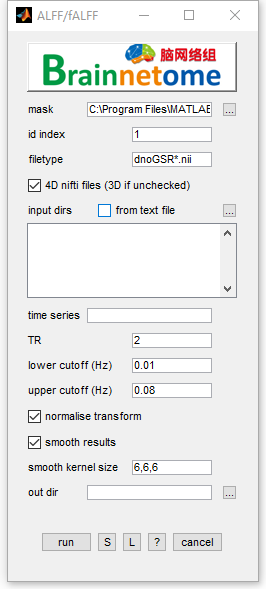ALFF/fALFF¶
ALFF is calculated as the amplitude of the time series in a certain frequency band, which is the averaged square root of the power spectral density of the filtered time series. To increase the stability of ALFF across subjects, fALFF was proposed as calculating the fraction of a certain frequency band against the whole available frequency band.

- mask: could be whole brain mask or gray matter mask.
- id index: identifier to find unique string for each subject
- filetype: files in the filetype will be searched in input directories.
- 4D nifti files: if the input data is 4D, check this item. Otherwise uncheck.
- input dirs: directories can be input either using a
*.txtfile or spm select window. - time series: choose the time series to calculate, seperated by ‘,’.
- TR: repetition time, used as sample frequency 1/TR to estimate width of frequency band.
- lower cutoff (Hz): lower cutoff for band pass filter.
- upper cutoff (Hz): upper cutoff for band pass filter.
- normalize transform: in output file, a suffix of _m means the output is divided by mean intensity in the mask; a suffix of _z means the output is subtracted by mean intensity and divided by standard deviation.
- out dir: output directory for saving results.
- Buttons:
- S: Save parameters of the current panel to a
*.matfile. The*.matcan be further loaded for the panel or be used in a script processing. - L: Load parameters from
*.matfor the current panel. - ?: Help information.
- S: Save parameters of the current panel to a
- References:
- Zang YF, He Y, Zhu CZ, Cao QJ, Sui MQ, Liang M, et al. Altered baseline brain activity in children with ADHD revealed by resting-state functional MRI. Brain & development 2007; 29(2): 83-91.
- Zou QH, Zhu CZ, Yang Y, Zuo XN, Long XY, Cao QJ, et al. An improved approach to detection of amplitude of low-frequency fluctuation (ALFF) for resting-state fMRI: fractional ALFF. J Neurosci Methods 2008; 172(1): 137-41.